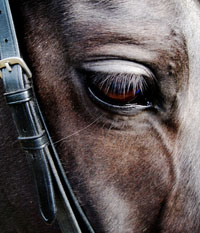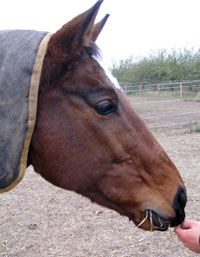The BHS Horse Owner's Certificates are specifically aimed at the first time horse owner, parent of horse owners or potential owners they are offered at four levels of knowledge with regard to the care and management of the horse and involve taking an examination. As there is no practical section to The BHS Horse Owner's Certificates they are not professional qualifications but BHS amateur qualifications only.
The BHS Horse Owners Certificate Syllabus
The BHS Horse Owners Certificate Level 1
- Knowledge of horse types, uses, colours and markings.
- Elementary stable management.
- Knowledge of care and maintenance required to keep a horse healthy and comfortable in a stable.
- Stable routine and safety in the stable.
- Safe handling of both the horse and equipment necessary for his well-being.
- A knowledge of substances in common use which require particular care andand/or storage.
- Identification of items of tack in common use and naming of the parts.
- Basic care of tack.
- Ability to take apart, inspect for safety, clean and reassemble.
- Reasons and principles of grooming.
- Knowledge of the items in a grooming kit and their use.
- Basic knowledge of shoeing and care of the foot.
- Recognition of signs of health and ill health and when to call a vet.
- Temperature, pulse, respiration and the signs of health.
- Preventative treatments - worming, flu-vac etc including a basic knowledge of the need to worm and vaccinate.
- Elementary principles of watering and feeding and the rules of feeding and watering.
- A knowledge of buying a horse including points to look for and the need for a vet to assess the horse before purchase.
- Elementary rules for preparing a horse for a ride including riding out on the roads; returning from a ride; and how to dress for riding.
The BHS Horse Owners Certificate Level 2
- The reasons for shoeing and recognition of when shoeing or re-shoeing is required.
- A knowledge of the basic structure of the foot.
- Knowledge of a farrier’s tools and use.
- Know how to remove a shoe safely in an emergency.
Recognition of common injuries and basic first aid. - Know how to arrest bleeding and treat different types of wounds.
- Knowledge of watering and feeding of the stabled horse and the horse at grass including feeding in all seasons and feeding for light work.
- Care and maintenance of grassland including the maintenance of fences, gates, shelter, watering etc.
- Care and improvement of the grassland to include a knowledge of harmful weeds and their control.
- The care of saddlery, including the inspection for soundness of saddles.
- A knowledge of the fitting and use of more items of equipment i.e. martingales,breastplates, boots etc.
- The necessity of insurance to cover all aspects of the horse and its use.
- Stable Routine for two horses which also includes all the extra jobs that need to be undertaken e.g. drains, guttering, paintwork, cleanliness of yard etc.
- A knowledge of the different types of bedding and their management including different systems e.g. deep litter.
- The Highway Code.
- The Country Code, including the correct and courteous use of bridleways.
The BHS Horse Owners Certificate Level 3
- The recognition, treatment and care of common injuries and ailments, further to Level Two.
- Changes from management in the stable to management at grass and viceversa.
- The procedures for getting a horse up from a period out at grass e.g.,teeth, worming etc. and the procedures for roughing-off a horse.
- Clipping, trimming and plaiting.
- Care and maintenance of horse transport; to include both horse boxes and trailers.
- A knowledge of the law regarding the transit of horses including weight ratios for trailers and legal requirement with regard to towing.
- Preparation of the horse for travel including aknowledge of equipment needed with regard to the length of journey and the climatic conditions.
- The care of the horse trekking and in competitive events.
- Understanding fitness and condition, and the maintenance of both.
- Knowledge of good and bad stable construction including different types of stabling.
- Basic requirements of planning regulations.
- Layout of stable yard to include handling and disposal of the muck heap.
- Knowledge of horse clothing and bandagingincluding their care and maintenance.
- Recognition of good and bad forage.
- Knowledge of different grasses found in hay samples and ability to identify weeds and poor grasses.
- Storage of forage
- Have a working knowledge of the costs involved in keeping a horse.
The BHS Horse Owners Certificate Level 4
- Knowledge of the main systems in the horse (Respiration, Reproduction,Digestive, Immune, etc.), their function and common problems associated with these systems, (COPD, Colic etc.)
- Knowledge of various grasses, conditions for growth and beneficial properties.
- Procedures for improving pasture i.e. drainage, cross grazing, re-seeding, fertilisers etc. Calendar of management for grassland. Haymaking - types and methods.
- Vitamins/Minerals - difference between them and why they may be deficient in the diet.
- Name main vitamins/minerals and their uses.
- Weights and types of feed available for: Riding School horses, Hunters, Competition Horses, etc.
- Knowledge of structure of the tooth and ageing characteristics. Description of structure of the mouth and common problems that may result from poor mouth conformation.
- Name and structure of different types of remedial shoes, describe the condition under which these shoes may be used and the way in which they affect improvement/relief.
- List the basic principles of sick nursing and the reasons/conditions for implementing these.
- Describe the way in which these principles may help to reduce severity of a condition/injury and any problems that may arise as a result.
- Outline the basic principles of fitting various saddles (dressage, jumping, cross-country, general purpose) and bridles (snaffle, double bridle).
- Describe the uses of specific ‘bits’ and gadgets, (draw reins, balancing reins, Market Harborough, De Gouge, etc.) and the way in which they work.
- List common stable vices and their possible causes and suggest ways to stop such vices and the preventative steps that can be taken to limit these.
- A general knowledge of The BHS and its Departments, Structure etc. Awareness of The BHS qualifications system and The BHS Register of Instructors.
- Action to be taken in the event of an accident. A knowledge of RIDDOR and legal obligations of an Instructor.
Candidate’s information packs are available from the BHS Examinations Department on request.
Please contact [email protected]





